Or How to Save Over $10,000 in Light Bulb Expenses.
 Besides being a dentist, manager, bookkeeper, CEO, chief bottle-washer, and cook… I’m the official “light-bulb changer.” And over the years, I noticed that it seems like I’m ALWAYS changing bulbs in my office.
Besides being a dentist, manager, bookkeeper, CEO, chief bottle-washer, and cook… I’m the official “light-bulb changer.” And over the years, I noticed that it seems like I’m ALWAYS changing bulbs in my office.
Most of the common areas in my office are illuminated by recessed flood lights. I’ve got 27 flood light fixtures. 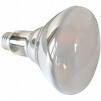 They use the BR-40 size bulbs. And, it seemed like they were burning out very quickly and frequently. And, like with many things, I procrastinated. Oftentimes, burned-out bulbs would remain in place for way longer than they should have. This simply doesn’t look good to patients and visitors to the office.
They use the BR-40 size bulbs. And, it seemed like they were burning out very quickly and frequently. And, like with many things, I procrastinated. Oftentimes, burned-out bulbs would remain in place for way longer than they should have. This simply doesn’t look good to patients and visitors to the office.
I’ll get those long-lasting bulbs!
I started buying the Philips Duramax bulbs, which were rated for 1-1/2 years of use. Their own marketing states: “Philips DuraMax® Long Life Reflector Flood Bulbs reduce the hassle of replacing light bulbs every few months, since all DuraMax products last longer than standard incandescent light bulbs.”
That should slow down the bulb-changing pace, right? Nope.
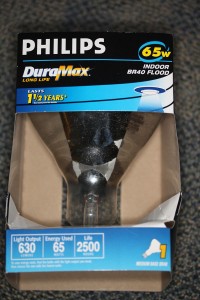
1-1/2 years? NOT! More like 3 – 4 months, at $8 a pop.
It still seemed like they weren’t lasting long at all. Finally, I started writing the install date with a Sharpie marker on each bulb, so I could determine how long the bulbs were lasting. I found that, on average, the “1-1/2 year” bulbs were lasting 3 – 4 months. Just lovely! And, each bulb was costing me about $8! I emailed Philips to see if they had any comments or suggestions. I never heard back from them.
I started doing some math. I’m weird that way. Twenty-seven light fixtures times 4 bulbs / fixture / year times $8 = $864 spent per year on these bulbs. Holy crap! That’s not to mention climbing up and down the ladder ONE HUNDRED AND EIGHT times a year. I’ve got better things to do.
We’re from the government. We’re here to help.
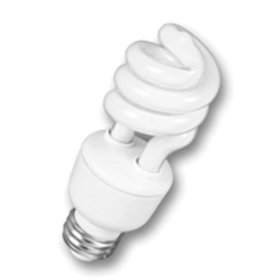
Low wattage. High suckage! Toxic!
As our ever-increasingly-intrusive government has mandated the banning of incandescent bulbs, we’ve all been subjected to the propaganda that the new more efficient CFL (compact fluorescent light bulb) is the panacea of lighting, embraced by tree-hugging greenies all over Eugene, Oregon. 😉 CFLs are those curly-cue funny looking bulbs. The problem with them is… well… they SUCK. The quality of light output is inferior to good ol’ incandescent lighting. Not only is the actual strength of the light reduced, the “warmth” of incandescent lighting is missing. They’re expensive. CFLs suck. They are promoted as using 1/5 the energy of an incandescent while lasting 6 – 10 times as long. Sounds good on the surface, doesn’t it? Keep reading.
I wonder how many of our elected representatives who voted to ban Thomas Edison’s brilliant, simple, and inexpensive invention have financial interests in the CFL producers?
Run, Forrest, run!
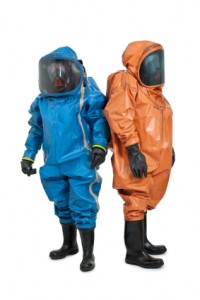
“You broke a CFL bulb? Step aside, sir!”
Another issue with CFLs is that they are hazardous waste. They contain mercury, which is not something we are supposed to throw into the garbage, right? For some real amusement, check out the EPA’s recommendations for what you should do if a CFL breaks in your house. Spoiler alert: You’re supposed to EVACUATE the room (pets, children, etc.)! You should also shut down your A/C or heating system. Then the clean-up procedure is one you’d expect a “HazMat” team in those bubble suits to execute. I’m not kidding. Check it out by clicking here.
CFLs were out, before they were even in. LEDs are da bomb.
Enter the LED light revolution. LEDs (light emitting diodes) have been around forever, starting with those old-style red digital displays in the original electronic calculators and digital watches. LEDs have evolved tremendously in recent years. They’re showing up everywhere from cars to flashlights and even the red / blue lights on police cruisers.
Modern LED lights put out some serious lumens. The bonus: They last a VERY long time, AND they are energy-efficient. While CFLs reportedly last 6 – 10 times as long as the old-school Edison-esque yellow bulbs, LEDs will last EIGHT times as long as CFLs. Booya!
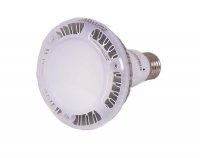 LEDs are about twice as efficient as CFLs (twice as many lumens per watt consumed). Double-booya! LEDs are also warmer, or more color-correct than CFLs. Finally, LEDs are dimmable, whereas most CFLs are not. Game, set, MATCH! For a Popular Mechanics report comparing incandescent vs. CFL vs. LEDs, click here.
LEDs are about twice as efficient as CFLs (twice as many lumens per watt consumed). Double-booya! LEDs are also warmer, or more color-correct than CFLs. Finally, LEDs are dimmable, whereas most CFLs are not. Game, set, MATCH! For a Popular Mechanics report comparing incandescent vs. CFL vs. LEDs, click here.
Ah… but, LEDs aren’t cheap. The prices continue to come down. Still, I liked what I was learning about LEDs, and I was tired of being a ladder-monkey. I bought 27 LED (Maxxima) bulbs for my recessed ceiling fixtures at $55 each. Yep… fifty-five bucks a piece! Stay with me, and keep reading. (Update on the price. They’ve gone down to $15 / each!)
To infinity and beyond!
The manufacturer states that they have a 40,000 hour life. Translated into a more understandable time-table (assuming 8 hours of use per day times 4 days a week times 50 weeks a year – my office hours), that equates to TWENTY-FIVE years of me not having to climb that ladder! But, just to be pessimistic, let’s say the manufacturer fibbed by a factor of two, and they only last 12 years.
More stunning math:
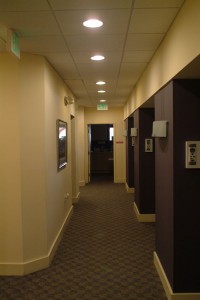
Wall sconces turned off to demo LEDs in ceiling (in my office). Photo taken without flash.
Remember I was spending $864 / year on regular “long-lasting” bulbs. If I had continued to buy the regular bulbs for the next 12 years, that comes to $10,368 spent on bulbs!!!
I just bought the new LED bulbs at $55 each for a total of $1,485. If they last only 12 years, I will have saved $8,883. If the manufacturer was accurate in their estimate of 40,000 hours, I will have saved $20,115!! Just in bulbs! Either way, the LED bulbs will pay for themselves in less than two years.
Also, according to the manufacturer, each bulb should save $20 per year in electric costs. If I multiply that times 27 bulbs times 25 years, it should save $13,500 on my power bill. This brings the total savings potential to $33,615 over the lifetime of the bulbs. I realize that is likely a very optimistic projection. But, I am perfectly happy with just the savings on bulbs using the pessimistic 12 year lifespan basis ($8,883). No matter how you look at it, it’s a no-brainer.
I’ve checked my power bills and compared the same months before the new LEDs to those months after. I’ve seen a SLIGHT (yet consistent) reduction in my bill. Here in sunny Florida, weather / temperature variations can account for significant differences in power bills (how much the A/C runs). So, it’s a bit more difficult to calculate any savings on my utility bill as a result of the LEDs.
At least I won’t break a leg.
I will readily and proudly admit I am NOT a “green warrior.” My car sucks gas like there’s no tomorrow. But, it goes like stink. I like that. But, when it comes to light, I just want to be able to see in the dark. And, if I can do that more cheaply and spend less TIME screwing in light bulbs at the top of a ladder, I’m all for it. I converted to LEDs in August of 2010. I haven’t been on the ladder since. Awesome.
You may or may not have a bunch of floodlights like I do in my office. But, any incandescents you do have, you might consider replacing with LEDs when the time comes.
PS… I see the price has come down for the bulbs I bought (from $55 each to $50).
PPS… One of my readers found a coupon code that will save 5% on your order. The code is “LED.” Clever, eh? Hey… 5% is 5%! It can add up to some bucks! The website again: Maxxima.
Update (9/14/15): The price for these LED bulbs has gone down significantly, making it even more of a no-brainer. I paid $55 each at the time of publishing this article (December 2011). And, ALL of those bulbs are still going strong. I’ve saved a net of about $2,000 just on bulb expenses in four years. Now the LED bulbs are $15 (fifteen) at Amazon.com!
(Back to top)
 Copyright protected by Digiprove © 2013 The Dental Warrior®
Copyright protected by Digiprove © 2013 The Dental Warrior® 
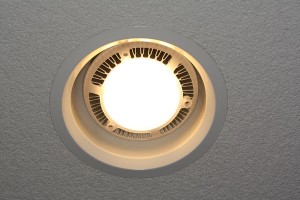
Hey Mike – I always get my subscription in the middle of the night – so your blog posts are one of the entertaining ways I get to start my day….even before coffee some mornings (like right now).
Great post – I am curious if you have installed LED in your operatory lighting? The results are similar – albeit the cost of 1 overhead light is $4000ish, the advantages are ‘night and day’. LED lights are cool white and you eliminate a lot of breakdowns (according to the manufacturer they should last many years with no bulb changes). In dental though – its’ not just about the bulb change as much as it’s about the actual view.
Worth a try if you haven’t! Would love to get your opinion…
Smile!
Warren
Hi Warren,
My operatory ceiling lights are standard fluorescent tubes. Each op has two banks of lights. So, $4,000 a pop is crazy and I don’t see any way that would have a positive ROI. Do you have a link to the system you’re referring to? I’m just curious. The price seems insanely high. I was able to replace ALL my floodlights (27 of them) with LEDs for just about $1500. At that price, it’s a no-brainer, and it has a good ROI (as illustrated in my blog article above).
It isn’t a good ROI on the lights. It’s just something that makes everyday life more comfortable – but beauty is in the eye of the beholder. Every clinic I installed one to try has decided the investment is worthwhile.
I suggest LED bulbs for your fiber optics (I think you may have already done this) to get an idea of the difference in lighting. It’s equivelant to the bright white lighting on newer vehicles – it really lights up the night (and is really obvious to other drivers)
You can definitely live without it – but many try it and wouldn’t go without it.
http://www.pelton.net/lights/helios-3000/
Smile!
Warren
After posting – I re-read and realized we may be thinking of two different things. I was thinking of the patient operators light – not the fluorescent. Oops! Told ya – need coffee before posting, even later in the day….
Warren
Oh….. I see. Nevertheless… $4,000?? I’ve currently got Adec track mounted lights. Very nice. They were expensive, too… part of the office build-out. But, they’ve become less important as I use a headlight (on my surgical telescopes). The light provided by a headlight is simply unsurpassed… and render any fiber-optics (on handpieces) obsolete. In fact, I took my fiberoptic system OUT. And, as I’ve bought new handpieces, they are the non-fiber-optic type now.
Loupes are a definite top 10 on my list of products every doctor should use….and many of the headlights are LED (http://www.ultralightoptics.com/overview.html) and offer, like you say, “unsurpassed” light.
You are right – the other lights could be rendered obsolete with this technology – and with the weight and size being so small – the price of one light is only around $500. Now THAT can give you an ROI!!
Someday I gotta make my way down to see your clinic Mike!
Warren
At this point, I think ALL the headlights on the market are LEDs. Mine (from Designs for Vision) is LED.
I’ve been using magnification and a headlight for at least 15 years now. I can’t (won’t) work without them.
I’d love to visit you in Saskatoon some day! How cool would that be?? 🙂
I LOVE people who “do the math”… Numbers don’t lie. That’s awesome. Guess who’s ordering LED’s without picking up a calculator? Thanks Mike.
Also include coupon code LED and save another 5%! Bam! I love google.
Cool, Jenn! I’m going to add that to the blog article in case folks don’t read down this far. Thanks!
Hi,
is there any LEDs to replace fluorescent ?
Thanks
Pingback: Higher MPG Cars = Higher Costs! What?? | The Dental Warrior® – A Blog for Dentists
So update…. i placed all 8 can lights in my kitchen in 2011 and haven’t replaced one!!! BAM … I actually can’t find the order information, but knew where I could. 🙂 Investing (or saving) in all the CAN lights in the office before year end … thanks Mike! Again!
Awesome! And, now the LED bulbs are quite a bit cheaper, too.